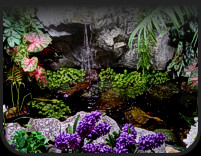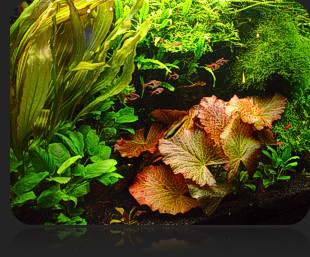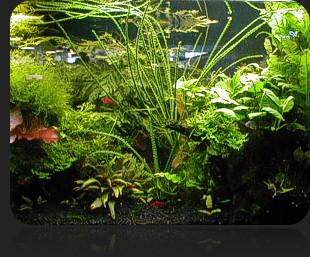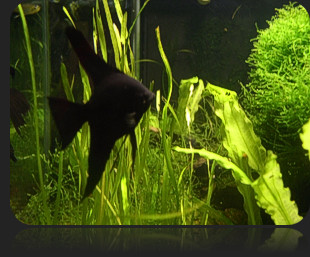 |
home page Aquarium Adventure carries the widest selection of aquariums, fish, corals & plants. |
| ABOUT USAQUATIC PROFESSIONALSLOCATIONSTIP SHEETSFRANCHISE |
 |
||
| We offer everything from do-it-yourself pond equipment and starter sets to full custom installation packages. Our experts can answer those really tough questions about installing and maintaining garden ponds...a service the hardware stores cannot provide. Come visit our store and take a tour! |
||
 |
||
 |
||
|
||
 |
||
Similar advances in technology and propagation which have made the marine aquarium hobby easier have also been developed for the live plant aquarist. With such innovation making live plant care easier today, the hobbyist must still have the proper understanding and equipment to be successful. Common ground for any aquarists is to keep a watchful eye on aquarium water conditions, feeding, lighting, and the growth and death of the animals and plants. Photosynthesis Nutrients As the tank ages, live plants will use up abundant nitrates, helping to minimize algae growth. Iron (Fe) is another important nutrient needed for healthy plant growth. Generally, most plants with a bright red, or reddish orange color indicate a regular need for iron additives. Green plant leaves that tend to “yellow” quickly may be showing signs of iron deficiency. Most good plant additives will contain nitrates, phosphates, iron, and other nutrients which can be administered easily and on a regular basis to the tank.
Intensity refers to the strength and color of the light. Most plants require the red and blue spectrum in sunlight. Hobbyists attempting to cultivate live plants must use fluorescent or metal halide lighting specifically designed to emit these spectrums. The strength of light needed will depend upon the size of the aquarium. Generally, two (2) watts of lighting per gallon is recommended for sufficient plant growth. Photoperiod represents the length of time the light is turned on. A ten to twelve (10-12) hour light cycle is suggested for a planted aquarium. Consistency in photoperiod can be obtained by purchasing an inexpensive light timer. Hobbyists can experiment with increasing or decreasing the photoperiod to affect the growth rate of their plants. Water Quality Parameters The pH (potential of hydrogen) of the water, whether it is low (acidic), neutral, or high (alkaline) also needs to be measured for the particular types of plants being kept. Most plants do well in lower to slightly higher than neutral pH. Test kits are available to monitor pH levels. To be successful in growing aquarium plants, a hobbyist must first reference the water quality for the type of plants desired and adjust water hardness and pH accordingly. There are several ways this can be done. One method is to use R.O. (reverse osmosis) or D.I. (deionized water). Like rainwater, R.O. and D.I. Water do not contain hard minerals, thus softening aquarium water. Another technique is to filter the aquarium water through a peat moss, as this will lower the pH of the water. The peat moss can also be placed in a power filter or under the gravel if using an under gravel filter.
When planting “bunch” plants, take the rubber band or lead weight off so that each strand can be prepped and planted. To prep the plant strand, a 1.5 inch bar stem is needed. Pull off all the leaves down to the node (where the leaf connects to the stem) which will allow the bare stem to grow roots. The plant stems can now be floated in the aquarium for a few days for roots to develop, or planted for roots to sprout in the substrate. Bare root plants need to be planted like outdoor plants. A hole in the substrate, large enough to accommodate the roots will need to be made. After gently placing the plant roots in the hole and spreading them out, carefully cover the roots with enough substrate to hold the plant from floating away. Make sure you don’t push the crown of the plant (the node from where all plant stems radiate) below the ground surface. Doing so, can cause damage to the crown, and alter growth. Plant species which root on wood and rocks will require a little help in getting started. After choosing the appropriate rock, wood, and plants, attach the plant base and roots to the surface using monofilament fishing line. Later, after the plant roots have grown and attached themselves securely to the wood or rock, the fishing line can be carefully cut away. Special Tips Carbon dioxide (CO2) gas, injected into the aquarium water can have a tremendous impact on plant growth. Photosynthesis occurs during daytime and with the help of light, plants consume CO2 and produce oxygen. During the night, when light is not present, plants consume oxygen and respire CO2. CO2 Gear
View All Fish Keeping Tip Sheets
|
||

 Keeping Live Plants in the Aquarium
Keeping Live Plants in the Aquarium Lighting
Lighting Planting
Planting